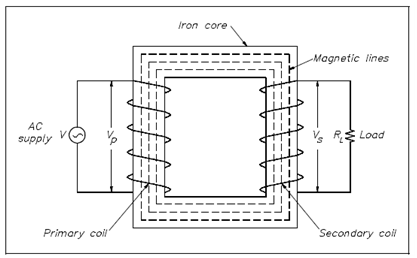Theory of Operation:
A transformer works on the principle that energy can be transferred by magnetic induction from one set of coils to another set by means of a varying magnetic flux. A magnetic flux is generated through an AC source.
The coil of a transformer which is energized from an AC source is known as the primary winding (coil), and the coil that delivers this AC to the load is known as the secondary winding (coil).
In the above figure, the primary and secondary coils are displays on separate legs of the magnetic circuit so which we could simply know how the transformer works. In fact, half of the primary and secondary coils are wound on each of the two legs, along with enough insulation among the two coils and the core to properly insulate the windings from one another and the core. A transformer wound, like as in Figure, will operate at a greatly decreased efficiency due to the magnetic leakage. Magnetic leakage is the category of the magnetic flux which passes by either one of the coils, but not by both. The larger, the distance among the primary and secondary windings the longer the magnetic circuit and the greater the leakage.

Figure: Core-Type Transformer
When alternating voltage is applied to the primary winding and an alternating current will flow which will magnetize the magnetic core, first in one direction and then in another direction. This alternating flux flowing around the whole length of the magnetic circuit induces a voltage in both the primary and secondary windings. Since both windings are linked by the similar flux, the voltage induced per turn of the primary and secondary windings have to be the similar value and similar direction. This voltage opposes the voltage applied to the primary winding and is known as CEMF (counter-electromotive force).